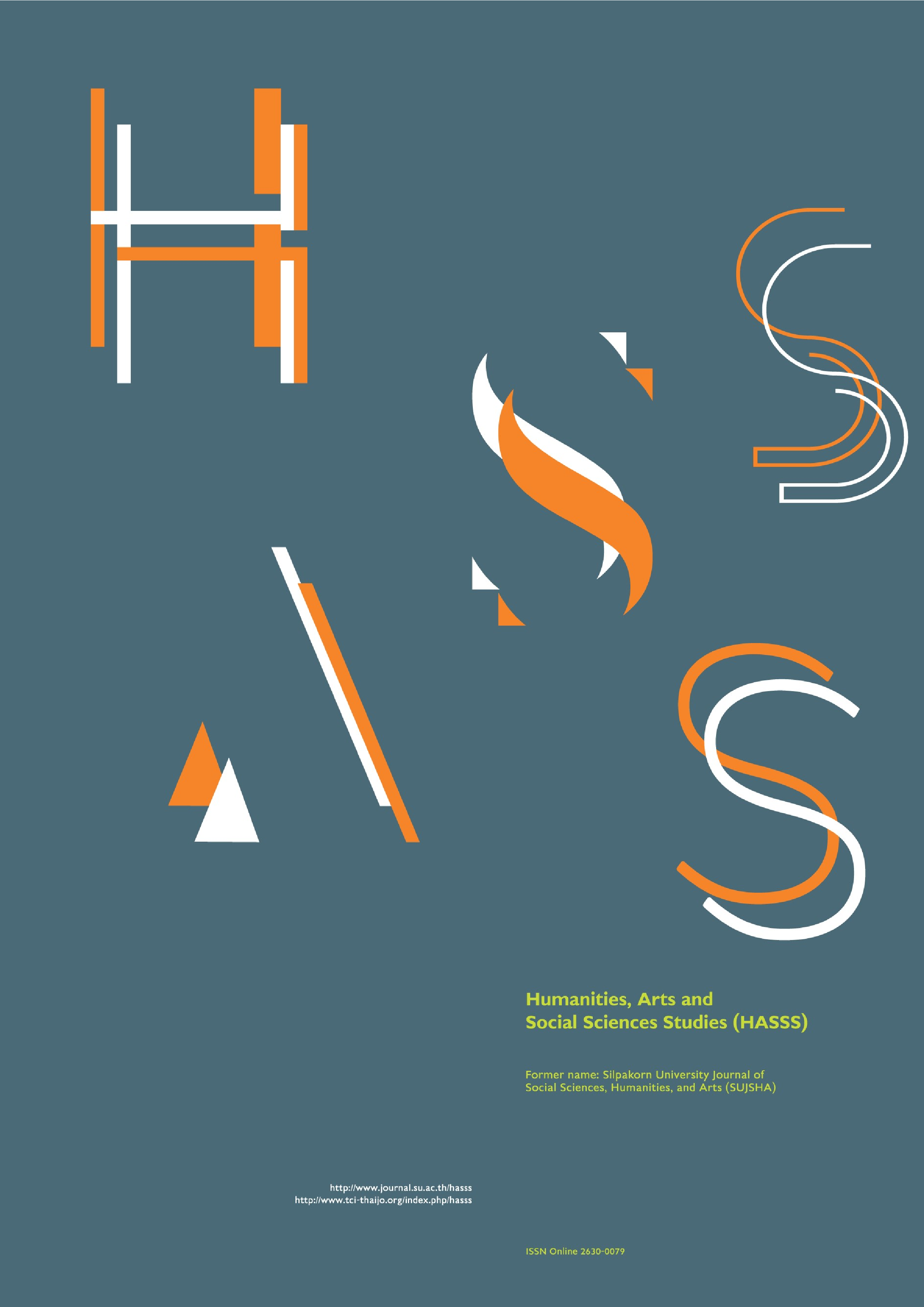Talking sex: Thai Phet and its connection to Thai drag performance as reflected by the language of kathoey performers in Chiang Mai
Main Article Content
Abstract
Drag performance has enjoyed increasing popularity around the globe, largely thanks to the success of US reality show RuPaul’s Drag Race. This specific brand of drag from the West has recently gained popularity in Thailand. Mainstream conceptualizations of drag performance often rely on a binary gender imaginary that differs from Thailand’s phet system. This qualitative study aimed to investigate contemporary discourse regarding Thai phet through interviews with Thai performers of drag and cabaret in Chiang Mai and to highlight how Thai drag negotiates the Thai phet imaginary. Eight performers based in Chiang Mai, representing a variety of performance backgrounds and phet presentations, were interviewed. Interviews were transcribed and underwent narrative and discourse analysis. The participants used phet vocabulary fluidly and contextually. The terms LGBT(Q), gay, sao song, hua pok, and kathoey were at times used to indicate distinct categories. At other times, however, any one of these words could be a part of a larger category of kathoey. The participants used the term kathoey to refer at different times to a particular feminine aesthetic presentation, an internal sense of self, or an over-the-top demeanor. Participants sometimes used language influenced by a binary understanding of mainstream drag performance but also acknowledged that Thai drag doesn’t fit that binary. The space of this newer brand of drag performance aligns well with an expansive category of kathoey. In this way, Thai drag actually challenges both Western concepts of sex/gender/sexuality and dominant conceptualizations of Thai phet, celebrating other ways of being for Thai kathoey.
Downloads
Article Details

This work is licensed under a Creative Commons Attribution-NonCommercial-NoDerivatives 4.0 International License.
All rights reserved. Apart from citations for the purposes of research, private study, or criticism and review,no part of this publication may be reproduced, stored or transmitted in any other form without prior written permission by the publisher.
References
Attaviriyanupap, K. (2015). The linguistic representation of gender in Thai. In M. Hellinger & H. Motschenbacher (Eds.), Gender across languages: Volume 4 (pp. 369–399). John Benjamins Publishing Company.
Benjanavee, K. (2017). Construction process of kathoey cabaret in Pattaya City [Master’s thesis, Burapha University]. Burapha University Library. https://digital_collect.lib.buu.ac.th/dcms/files/57910281.pdf [in Thai]
Brennan, N., & Gudelunas, D. (Eds.). (2017). RuPaul’s drag race and the shifting visibility of drag culture: The boundaries of reality tv. Palgrave Macmillan.
Jackson, P. A. (2000). An explosion of Thai identities: Global queering and re-imagining queer theory. Culture, Health & Sexuality, 2(4), 405–424. https://www.jstor.org/stable/3986699
Jackson, P. A. (2009). Capitalism and global queering: National markets, parallels among sexual cultures, and multiple queer modernities. Journal of Lesbian and Gay Studies, 15(3), 357–395. https://doi.org/10.1215/10642684-2008-029
Käng, D. B. (2012). Kathoey “in trend”: Emergent genderscapes, national anxieties and the re-signification of male-bodied effeminacy in Thailand. Asian Studies Review, 36(4), 475–494. https://doi.org/10.1080/10357823.2012.741043
Levin, S. (2018, March 8). Who can be a drag queen? RuPaul’s trans comments fuel calls for inclusion. The Guardian. https://www.theguardian.com/tv-and-radio/2018/mar/08/rupaul-drag-race-transgender-performers-diversity
Morris, R. C. (1994). Three sexes and four sexualities: Redressing the discourses on gender and sexuality in contemporary Thailand. Positions, 2(1), 15–43.
Nguyen, T. H. (2018). Wer aesthetics in contemporary queer Thai cinema. Camera Obscura, 33(1), 139–169. https://doi.org/10.1215/02705346-4336872
Nithiwana, C. (2021). Doing and undoing of Kathoei under heterosexual discourse [Master’s thesis, Chiang Mai University]. The Graduate School, Chiang Mai University. https://cmudc.library.cmu.ac.th/frontend/Info/item/dc:161467 [in Thai]
Nueng diaw Jai Sira draek khwin phan na [One and only Jai Sira, the drag queen of one thousand faces]. (2018, December 15). Thairath Online. https://www.thairath.co.th/news/local/1444976 [in Thai]
Pattanalertpun, N. (2018, February 18). Draek khwin maichai nang cho: Khui kap Pan Pan Nakprasert phithikon ruam raikan Drag Race Thailand [Drag Queens aren’t showgirls: Yalking to Pan Pan Nakprasert, co-host of Drag Race Thailand]. The Matter. https://thematter.co/entertainment/drag-race-thailand-interview/45986 [in Thai]
Pieterse, J. N. (2009). Globalization and culture: Global mélange. Rowman & Littlefield.
Pramoj na Ayutthaya, P. (2003). Contesting identities of ‘Kathoei’ in cabaret show [Master’s thesis, Chiang Mai University]. CMU Intellectual Repository. http://cmuir.cmu.ac.th/jspui/handle/6653943832/35461 [in Thai]
Rattanadilok Na Phuket, W., & Kasa, D. (2020). Drag queen: self-presentation of the contestants in a reality show “Drag Race Thailand”. Manutsayasat Wichakan, 27(1), 160–187. https://so04.tci-thaijo.org/ index.php/abc/article/view/230374 [in Thai]
Samakkeekarom, R. (2020). Khumue kanpatibat ngansue nai kannamsanoe praden khwamlaklaithangphet [LGBTQ media guidebook]. The Foundation of Transgender Alliance for Human Rights: ThaiTGA. [in Thai]
Sawatchin, W. (2017). Cabaret show at cabaret theatre in Pattaya City. Music and Performing Arts Journal, 3(2), 99–116. [in Thai]
Sopitarchasak, S. (2023). What it means to be a drag queen in Thailand: A qualitative study. Asia-Pacific Social Science Review, 23(1), 1–18. https://www.dlsu.edu.ph/wp-content/uploads/pdf/research/journals/apssr/2023-march-vol23-1/ra-1.pdf
Tan, Q. H. (2014). Orientalist obsessions: Fabricating hyper-reality and performing hyper-femininity in Thailand’s kathoey tourism. Annals of Leisure Research, 17(2), 145–160. http://dx.doi.org/10.1080/11745398.2014.906312
Villar, L. B. E. (2017). Sisters, boyfriends, and the big city: Trans entertainers and sex workers in globalized Thailand [Master’s thesis, Chulalongkorn University]. Chulalongkorn University Theses and Dissertations (Chula ETD). https://digital.car.chula.ac.th/chulaetd/786
Wuen, W. Y. (2007). Catwalking the gender tightrope: A study of the Kathoey and transsexual beauty contests in Thailand [Master’s thesis, National University of Singapore]. ScholarBank@NUS Repository. http://scholarbank.nus.edu.sg/handle/10635/23189


